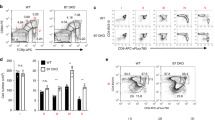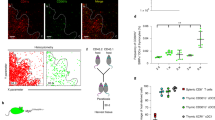Abstract
To generate antigen-specific responses, T cells and antigen presenting cells (APCs) must physically associate with each other and elaborate soluble factors that drive the full differentiation of each cell type. Immediately after T cell activation, CD4 T cells can produce both interferon γ (IFN-γ) and interleukin 4 (IL-4) before polarization into distinct T helper subsets. Inhibition of IL-4 during mixed allogeneic lymphocyte culture resulted in a defect in the ability of APCs to generate sufficient costimulatory signals for activation of alloreactive T cells. In vivo, a deficiency in IL-4 production inhibited the activation of alloreactive IL-2–, IL-4– and IFN-γ–producing CD4 T cells in mice challenged with allogeneic skin grafts, resulting in prolonged skin graft survival. Thus, production of IL-4 by CD4 T cells helps activate alloreactive T cells by affecting APC function.
This is a preview of subscription content, access via your institution
Access options
Subscribe to this journal
Receive 12 print issues and online access
$209.00 per year
only $17.42 per issue
Buy this article
- Purchase on Springer Link
- Instant access to full article PDF
Prices may be subject to local taxes which are calculated during checkout






Similar content being viewed by others

References
Auchincloss, H. Jr & Sultan, H. Antigen processing and presentation in transplantation. Curr. Opin. Immunol. 8, 681–687 (1996).
Gould, D. & Auchincloss, H. Jr Direct and indirect recognition: the role of MHC antigens in graft rejection. Immunol. Today 20, 77–82 (1999).
Turka, L. A. et al. T-cell activation by the CD28 ligand B7 is required for cardiac allograft rejection in vivo. Proc. Natl Acad. Sci. USA 89, 11102–11105 (1992).
Lenschow, D. J., Walunas, T. L. & Bluestone, J. A. CD28/B7 system of T cell costimulation. Ann. Rev. Immunol. 14, 233–258 (1996).
Valle, A., Aubry, J. P., Durand, I. & Banchereau, J. Il-4 and IL-2 upregulate the expression of antigen B7, the B cell counterstructure to T cell CD28: an amplification mechanism for T-B cell interactions. Int. Immunol. 3, 229–235 (1991).
Nabavi, N. et al. Signaling through the MHC class II cytoplasmic domain is required for antigen presentation and induces B7 expression. Nature 360, 266–268 (1992).
Chen, L. et al. Costimulation of antitumor immunity by the B7 counterreceptor for the T lymphocyte molecules CD28 and CTLA-4. Cell 71, 1093–1102 (1992).
Lin, H. et al. Long-term acceptance of major histocompatibility complex mismatched cardiac allografts induced by CTLA4Ig plus donor-specific transfusion. J. Exp. Med. 178, 1801–1806 (1993).
Nakamura, T., Kamogawa, Y., Bottomly, K. & Flavell, R. A. Polarization of IL-4 and IFN producing CD4+ T cells following activation of naive CD4+ T cells. J. Immunol. 158, 1085–1094 (1997).
Mosmann, T. R. & Coffman, R. L. Th1 and Th2 cells: different patters of lymphokine secretion lead to different functional properties. Annu. Rev. Immunol. 7, 145–173 (1989).
Kuhn, R., Rajewsky, K. & Muller, W. Generation and analysis of interleukin-4 deficient mice. Science 254, 707–710 (1991).
Stack, R. M. et al. IL-4 treatment of small splenic B cells induces costimulatory molecules B7–1 and B7-2. J. Immunol. 152, 5723–5723 (1994).
Li, X.C. et al. IL-2 and IL-4 double knockout mice reject islet allografts: a role for novel T cell growth factors in allograft rejection. J. Immunol. 161, 890–896 (1998).
Sawada, T., Wu, Y., Sachs, D. H. & Iacomini, J. CD4+ T cells are able to reject class I disparate allografts. Transplantation 64, 335–340 (1997).
Rosenberg, A. S. & Singer, A. Cellular basis of skin allograft rejection: An in vivo model of immune-mediated tissue destruction. Annu. Rev. Immunol. 10, 333–358 (1992).
Albert, M. L., Sauter, B. & Bhardwaj, N. Dendritic cells acquire antigen from apoptotic cells and induce class I-restricted CTLs. Nature 392, 86–89 (1998).
Sauter, B. et al. Consequences of Cell Death. Exposure to necrotic tumor cells, but not primary tissue cells or apoptotic cells, induces the maturation of immunostimulatory dendritic cells. J. Exp. Med. 191, 423–434 (2000).
Mencacci, A. et al. Endogenous Interleukin 4 is required for development of protective CD4+ T helper type 1 cell responses to Candida albicans. J. Exp. Med. 187, 307–317 (1998).
Suzuki, Y. et al. IL-4 is protective against development of Toxoplasmic encephalitis. J. Immunol. 157, 2564–2569 (1996).
Schuler, T. et al. T helper cell type 1-associated and cytotoxic T lymphocyte-mediated tumor immunity is impaired in interleukin 4 deficient mice. J. Exp. Med. 189, 803–810 (1999).
Kamogawa, Y. et al. The relationship of IL-4- and IFN-γ producing T cells studied by lineage ablation of IL-4-producing cells. Cell 75, 985–995 (1993).
Perez, V. L. et al. Induction of peripheral T cell tolerance in vivo requires CTLA-4 engagement. Immunity 6, 411–417 (1997).
Davies, J. D. et al. T cell regulation in adult transplantation tolerance. J. Immunol. 157, 529–533 (1996).
Sarmiento, M., Glasebrook, A. L. & Fitch, F. W. IgG or IgM monoclonal antibodies reactive with different determinants on the molecular complex bearing Lyt2 antigen block T cell-mediated cytolysis in the absence of complement. J. Immunol. 125, 2665–2672 (1980).
Dialynas, D. P. et al. Characterization of the murine T cell surface molecule designated L3T4, identified by monoclonal antibody GK1.5: similarity of L3T4 to the human Leu 3/T4 molecule. J. Immunol. 131, 2445–2451 (1984).
Ohara, J. & Paul, W. E. Production of a monoclonal antibody to and molecular characterization of B-cell stimulatory factor-1. Nature 315, 333–336 (1985).
Chomczynski, P. & Sacchi, N. Single-step method of RNA isolation by acid guanidinium thiocyanate-phenol-chloroform extraction. Anal. Biochem. 162, 156–159 (1987).
Acknowledgements
We thank S. Pillai, J. J. Lafaille and H. Winn for critical review of the manuscript; N. Cretin for assistance with skin grafts; P. Heeger for advice on performing ELISPOT assays; and D. H. Sachs for monoclonal antibodies 11B11, 2.43 and GK1.5. Supported in part by the National Institutes of Health grant RO1 AI43619 (to J.I.).
Author information
Authors and Affiliations
Corresponding author
Rights and permissions
About this article
Cite this article
Bagley, J., Sawada, T., Wu, Y. et al. A critical role for interleukin 4 in activating alloreactive CD4 T cells. Nat Immunol 1, 257–261 (2000). https://doi.org/10.1038/79811
Received:
Accepted:
Issue Date:
DOI: https://doi.org/10.1038/79811
This article is cited by
-
Stellate Ganglion Block Improves the Proliferation and Function of Splenic CD4 + T Cells Through Inhibition of Posthemorrhagic Shock Mesenteric Lymph–Mediated Autophagy
Inflammation (2021)
-
Tolerance to MHC class II disparate allografts through genetic modification of bone marrow
Gene Therapy (2013)
-
Renal transplantation in the elderly
International Urology and Nephrology (2009)
-
IL-4 instructs TH1 responses and resistance to Leishmania major in susceptible BALB/c mice
Nature Immunology (2001)


